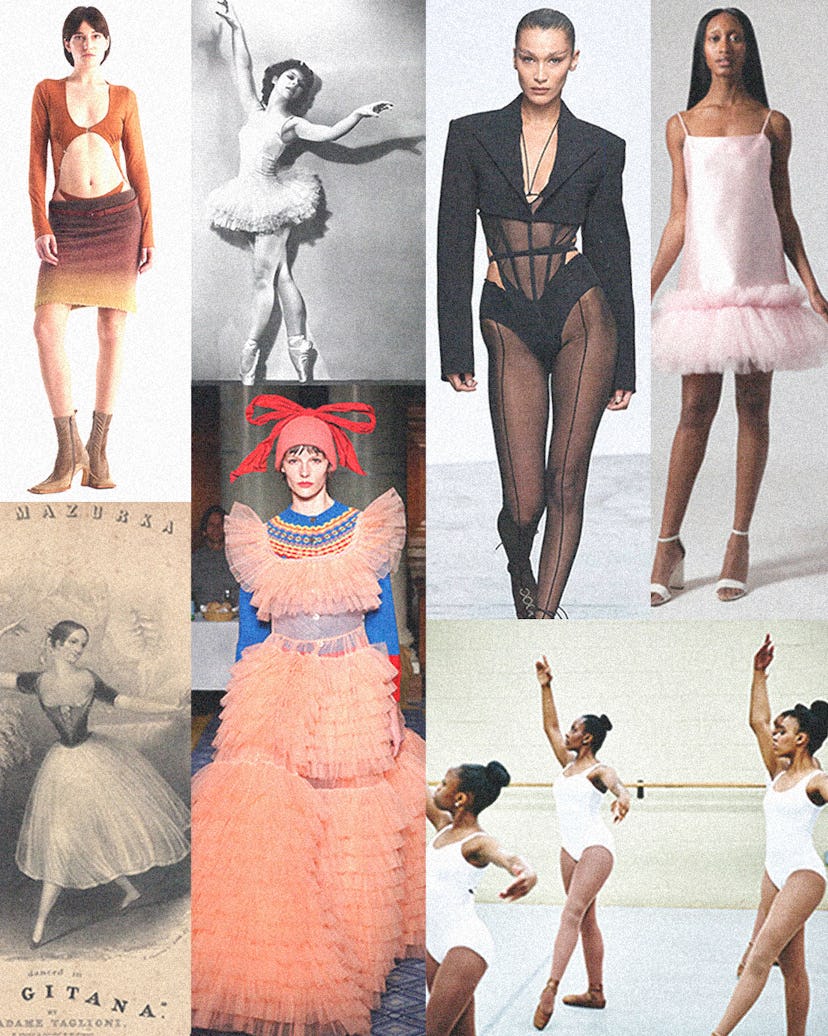Fashion and the Rise of Balletcore

Fashion and ballet have had an intrinsic connection for what feels like centuries. Essential items like bodysuits, tulle mini-skirts, leggings, and ballet flats have a timeless quality—yet ballet-inspired fashion is entirely of-the-moment. Consider the spring 2022 runways, where the references could be palpably felt. Simone Rocha’s tulle tutu dresses, Molly Goddard’s big statement gowns, Halpern’s fairly literal tribute to ballet, as well as Lanvin’s tutu-like skirts and Giambattista Valli’s frothy gowns—even Zara recently collaborated with the New York City Ballet. Plus, it’s impossible to ignore the influx of ballet flats that have sparked conversations on the return of the early aughts trend. With the balletcore hashtag trending on TikTok and Gen Z showing how they reinterpret the aesthetic while American Ballet Theater stars make their mark on the platform, it feels like ballet is reclaiming itself for a new generation.
Ballet’s unofficial fashion debut dates back to the 1830s. “The great Romantic-era ballerina of the 1830s and 1840s, Marie Taglioni, was such a big star in Europe that fabrics, corsets, and even candy were named for her and her most famous role, La Sylphide,” explains Patricia Mears, deputy director of FIT and curator of the 2020 exhibition “Ballerina: Fashion’s Modern Muse.” “Even as a young princess, Queen Victoria was a huge fan and named one of her horses Taglioni.”
Fast forward to the 1930s, when ballet fashion really made its mark. “From the 1930s to the present, the tutu-inspired evening dresses fabricated with materials such as silk tulle and chiffon had silhouettes inspired by her bell-shaped skirts and fitted bodices, and used colors long associated with ballet—mainly white and pink,” Mears says. A little over ten years later, the public was given the ballet flat silhouette. “Designer Claire McCardell, unable to procure shoes for a fashion presentation in 1942, paired her designs with real ballet slippers by the dancewear company Capezio,” Mears adds. “The idea, perhaps first proposed by fashion editor Diana Vreeland in 1941, became so popular during that decade that Capezio began to make street-worthy versions.”
But why is ballet the object of fashion’s obsession in 2022? There are two main reasons. Balletcore is an extension of the new wave of bodycon fashion we’ve been seeing in what inches nearer toward a post-pandemic world. The tighter, shorter, more sheer silhouettes from labels like Mugler, Ottolinger, KNWLS, and Givenchy are all about showing curves in a new way—and ballet fashion certainly embraces the body.
Second, the aesthetic lives close to ath-leisure, a category that has transformed in recent years. The original ath-leisure of the mid aughts was all about normcore and sweatpants. But with brands like SKIMS focusing on bodycon looks that are sleeker and more editorial, the next evolution of the trend is softer, more feminine, and more diversely layered. “I recently made printed knit pants to go over our tights,” explains Renea LaRiviere, the designer behind Zepherina, who has tapped into the trend. “It’s all about movement and comfort for me while running around this city—and then I’ll throw on one of our tops with a dollhouse jacket over it.”
In fact, a whole host of fashion’s rising designers are informing the new ballet aesthetic. For Jackson Wiederhoeft, tulle tutus and embroidered leotards have become a staple of every collection; collaborations with movement director Austin Goodwin are frequent. “There’s a lot of charm in ballet being unapologetically old-fashioned, like a horse-drawn carriage or grandma’s photo album with the quilted cover and frilly edges,” he adds. “There’s a time-traveling sensibility to it.”
Likewise, the up-and-coming designer Kristin Mallison is upcycling pointe shoes into ballerina-themed corsets. She began sourcing old pointe shoes about eight months ago, when she decided to repurpose the satin exterior, ankle ribbons, and elastic drawstrings into bodices. “I love the way that ballet is both lovely and brutal at the same time,” she says. “On the surface, it presents as very gentle, delicate, and pretty—but there is actually an elite athleticism that is required to achieve that, and it takes a cruel toll on the body. Aesthetically, I’m interested in both of these parts working together.”
For Nomasei, the footwear brand founded by Paule Tenaillon—a designer with 20 years of ballet under her belt—the iconic shoe serves as a reference, too. The label’s Aria style takes inspiration from the square shape of the pointe shoe, while the Lido shoe is inspired by dancer Isadora Duncan. “Ballet is always on my mind when creating shoes. It helps me to make elegant and delicate yet comfortable shoes that bring a true freedom of gesture,” she says. “Nomasei shoes are clearly thought to dance with, because if we can dance, we can certainly walk.”
In some ways, wearing ballet-inspired fashion in 2022 feels like an unabashedly strong statement of femininity. Interestingly enough, that concept has much to do with its history. “Fashion’s embrace of ballet had a lot to do with the changing views about performing artists,” Mears says. “Until the 20th century, they were looked down upon by the upper and middle classes. This was especially true with regards to women dancers and few art forms have been as decidedly female as classical ballet. As the great choreographer George Balanchine succinctly stated: ‘ballet is woman.’”
“Ballet inspirations are always going to be showing up in fashion because there’s an irresistible romanticism and grace to the style,” adds Taylor Tomasi Hill, fashion and creative director of the AI shopping platform, The Yes. “You see ballet flats and tulle skirts and think of dancers, Audrey Hepburn in Roman Holiday, super chic Parisiennes… Reality has been harsh lately, so there’s a bit of escapism in these pieces.”